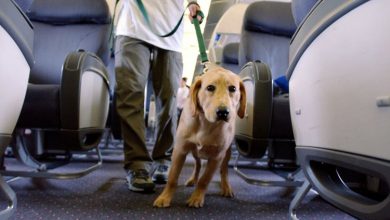Pets & Animals
How do service dogs provide support?
More than loving pets with a goal, highly trained service dogs spend weeks learning how to best assist their handlers perform important life tasks despite bodily or psychiatric challenges. For handlers and service dogs equally, extreme commitment to working together contributes to life-changing partnerships.
The Americans with Disabilities Act spells out the kinds of jobs service dogs perform. Protecting a personhaving a seizure, calming a person who has PTSD through an anxiety attack and reminding a person with mental illness to take prescribed drugs also qualify.
Service dogs perform some pretty amazing feats, says Dr. Carol (C.J.) Betancourt, a retired doctor, service-dog consumer and co-founder of their Arizona-based Foundation for Service Dog Support. “We have a number of clients with seizures that have gotten dogs,” Betancourt says. “Many of these dogs have the ability to detect the seizure until it occurs. They could warn the person so that they will sit or lay down on the ground.”
Individuals with diabetes may benefit from using a service dog who will alert them to hazardous high and low glucose levels. “We will usually take saliva samples during the training: 1 of when the sugar is high and among when the sugar is low,” Betancourt explains. “Our dogs are trained to twist around; to go in a circle in one direction if it’s high and in the opposite direction if it’s low.”
When patients develop a mobility challenge, Betancourt would enjoy her fellow doctors to broaden their treatment choices. “Rather than ordering them a wheelchair, a service dog should be a part of this dialogue,” she says.
His physical recovery from the gunshot wound to his abdomen took weeks following a lot of his intestines were removed. More operation to a busted arm, nerve damage and back issues were added physical reminders.
“What I did not expect at all that was the emotional issues I endured,” Sefranka states. I didn’t need to go to work. I didn’t want to associate with folks at work. I basically tried to remain hidden.”
His results from cognitive behavioral treatment and EMDR, frequently utilized to treat post-traumatic anxiety disorder, were blended. Digestive issues limited medication choices. His wife began exploring service dogs, but since the FSDS program centers around golden retrievers (who discard ), the couple looked elsewhere in the beginning. Nevertheless, they found too-long wait lists and too-high prices at other service bases. Finally, they bought their own service dog — a poodle called Digby — and training started.
Following about 18 months of fundamental then individualized coaching, Digby helps Sefranka by retrieving objects, opening doors and executing an assortment of other physical activities, including serving as a balance and brace when the detective struggles with hip stability linked to the bullet’s exit-wound harm.
“He can really pick up and sense once I have anxiety problems,” he says. Because I do not take the drugs, I want grounding a great deal of times. He will lay across me put pressure on me, which helps ground me back to reality.”
For Sefranka, PTSD means regular spells of nightmares, night tremors, anger problems, isolation and melancholy . “Digby’s been a crucial component in me moving ahead,” he says. “Since I got him, I have managed to return to work. I have managed to return in people and kind of restart my life as normal.”
Canine Companions for Independence, located in Santa Rosa, California, works with customers with disabilities from a wide assortment of conditions such as spinal cord injury, post-polio syndrome, multiple sclerosis and cerebral palsy. “Almost anything that ends in a person using a wheelchair, scooter or walker,” says CEO Paul Mundell. They also set the Labradors they breed as hearing dogs and facility dogs, which are trained to work with professional health professionals in settings such as hospital rehabilitation units.
They also place dogs known as skilled companions. “It is typically the child and one or both parents and the dog who form the group,” Mundell says. “Frequently we make those kinds of placements either with children who have Down syndrome or autism or another disability but for whom a service dog is not yet an option, possibly because they are too young to independently deal with a dog.”
Emotional support animals are different in that, for starters, they don’t need to be dogs. “It is an animal whose existence offers emotional or psychological comfort to the person,” Mundell says. “It does not have any special training.”
Mundell’s team”strongly opposes” sites where anyone can get an internet certification and a doggie vest with a patch to get pets access to public areas where service dogs are permitted. Rather, he says, dogs that aren’t properly trained may attack other dogs, be disruptive or leave messes in shops or restaurants — and make backlash for valid service teams.
Training a genuine service team is pricey. “That price covers essentially 10 decades of service.
And”What task or work has the dog been trained to carry out?”
“Those people with service dogs using them in a legitimate fashion — we are just like anybody else in society,” says Sefranka, whose currently serves on the FSDS board. “We are not trying to game the system. We are not trying to pull the wool over anybody’s eyes since we just need to have our dog with us. In several cases, these are animals that give a health function and are a medical necessity.”




